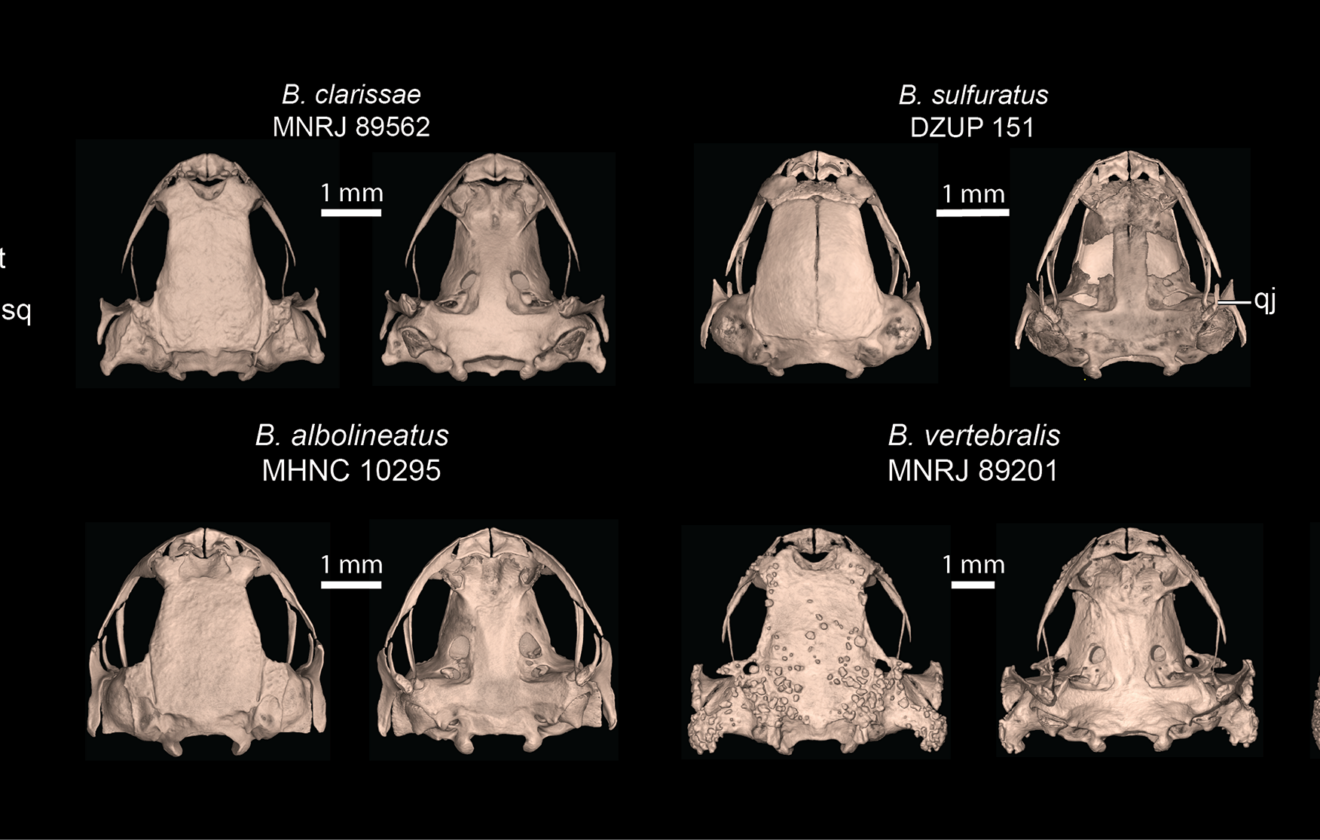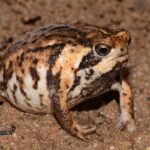- Brachycephalus vertebralis: Exploring the Enchanting World of Brazil's Tiny Pumpkin Toadlet
- Taxonomy and Classification
- Natural Habitat: The Forest's Secret Floor
- Physical Characteristics: Little Giants of Color and Defense
- Behavior and Life Cycle: Dancing Amid the Litter
- Ecological Role: Small Scale, Big Impact
- Threats and Conservation Status: Fragile Ambassadors in a Changing World
- Cultural and Scientific Significance: Tiny Teachers
- Conclusion: Discovering the Grandeur in Miniature
Brachycephalus vertebralis: Exploring the Enchanting World of Brazil’s Tiny Pumpkin Toadlet#
In the moist and mossy depths of Brazil’s Atlantic Forest, hidden among leaf litter and lush green ferns, lives a creature small enough to balance upon your fingertip—the remarkable and quietly charismatic Brachycephalus vertebralis. Often referred to lovingly as the “Pumpkin Toadlet,” despite its frog classification, this vibrant amphibian enchants every naturalist fortunate enough to stumble upon it. Measuring just a few millimeters in size, this miniature marvel holds within its petite form stories of adaptation, survival, and ecological significance, making it a captivating character within Brazil’s intricate tapestry of wildlife.
One intriguing characteristic sets the species apart from much of its amphibian brethren: it lacks the ability to effectively jump or leap gracefully like other frogs. Due to its tiny limbs, the Pumpkin Toadlet often tumbles and topples humorously after attempting leaps. Yet, this seemingly awkward disposition has captured global scientific curiosity, creating a species that simultaneously delights and perplexes herpetologists and nature lovers alike.
Taxonomy and Classification#
Understanding Brachycephalus vertebralis begins by exploring its systematic place within the animal kingdom. This species belongs to the family Brachycephalidae, a small yet fascinating group distinguished by their incredibly compact bodies, reduced limbs, and ornamented skulls. Brachycephalus—the genus under which our little Pumpkin Toadlet falls—is renowned among researchers as a genetic and evolutionary goldmine, home to various diminutive and brightly colored amphibians endemic solely to the forests along Brazil’s Atlantic coast.
The species epithet “vertebralis,” derived from Latin, refers aptly to peculiar vertebral structures and the pronounced bony plates and ridges along its tiny spinal column. Closely related in morphology and genetic lineage to species such as Brachycephalus pitanga and Brachycephalus ephippium, the Pumpkin Toadlet sits snugly within a clade marked by bold coloration and potent defensive toxins.
Natural Habitat: The Forest’s Secret Floor#
The Pumpkin Toadlet, exclusively endemic to Brazil, has a remarkably restricted geographic range, found only within select regions of the southeastern portion of the Atlantic Rainforest biome. Region-specific populations reside scattered across mist-filled mountain forests at elevations ranging from approximately 700 to 1200 meters above sea level. Here, persistent humidity, mild temperatures, and dense vegetation provide the optimal conditions that these minute amphibians depend upon entirely.
Underneath canopies draped with dripping bromeliads, epiphytic orchids, and curtain-like strands of Spanish moss, a rich carpet of brittle leaves and moist earth creates an essential microhabitat. This decomposing leaf litter, teeming with minuscule life forms, shelters millions of insects, mites, and other tiny creatures—providing a banquet perfectly tailored for these microfrogs.
The Pumpkin Toadlets exhibit an extraordinary fidelity to these specialized microhabitats, rarely venturing outside the leaf litter or lower vegetation layers. This ecological preference underscores their dependence on a healthy, undisturbed Atlantic Forest ecosystem, as even minor habitat alterations can threaten their delicate equilibrium.
Physical Characteristics: Little Giants of Color and Defense#
At first glance, finding Brachycephalus vertebralis might seem akin to a search for needles in a rainforest-shaped haystack—their diminutive sizes averaging merely 10–15 millimeters hardly rivals a thumbnail’s diameter. Yet despite their elusive stature, few forget them once seen. Undeniably charismatic, Pumpkin Toadlets possess vibrant hues ranging from intense yellows and golds to deep oranges—a dazzling palette that profoundly contrasts the muted greens and browns of their leafy habitat.
Beyond mere aesthetics, this brilliant coloration functions as aposematic warning signals, advertising their potent skin secretions to would-be predators. Researchers have identified complex alkaloid toxins hidden beneath their vividly pigmented skin, paralleling the chemical defenses seen in poison-dart frogs from distant Central American jungles.
Perhaps most fascinating are their peculiar anatomical features. Unlike typical frogs, Brachycephalus vertebralis has extremely compact bone structures, with fused vertebrae and well-pronounced dorsal bones, giving the tiny creature an armored appearance upon close inspection. These adaptations are likely related to predator deterrence and internal rigidity, helping safeguard vital organs within their concise yet robust frame.
Behavior and Life Cycle: Dancing Amid the Litter#
Life within the leaves is a quietly bustling affair for this frog species, whose daily rhythm revolves around search and survival. Active primarily during the daytime, these diurnal amphibians navigate their miniature universe slowly, with cautious movements minimizing exposure to predators. Watching them carefully traverse a crumbling leaf, tiny limbs gripping with precarious delicacy, is akin to observing an explorer navigating rugged terrain.
Feeding Strategies and Prey#
Lacking powerful limbs for leaping or bounding, Pumpkin Toadlets rely upon patient stalking and ambush tactics to secure their meals. Their diet primarily consists of mites, small ants, springtails, and other minute invertebrates abundant within their chosen domain. Equipped with surprisingly quick and precise tongues, they deliver sudden, accurate strikes, consuming numerous tiny prey daily to satisfy their energetic needs.
Mating Calls and Reproduction#
Despite being virtually voiceless to the human ear, males of Brachycephalus vertebralis produce faint, high-frequency calls meant to attract potential mates. Recent discoveries, however, indicate a puzzling evolutionary twist: due to anatomical constraints, Pumpkin Toadlets cannot effectively hear their own mating calls, throwing intriguing light upon selective pressures shaping their reproductive strategies.
Females lay their eggs terrestrially within moist leaf litter, foregoing aquatic tadpole stages entirely. Instead, direct development occurs within the eggs themselves; miniature replicas of adult frogs hatch directly from eggs, immediately adapted to terrestrial life. This unique reproductive strategy, common among Brachycephalus species, further emphasizes the delicate ecological tapestry that sustains these marvelously adapted creatures.
Ecological Role: Small Scale, Big Impact#
Although modest in physical stature, these tiny amphibians wield impressive ecological influence. Serving as specialists in decomposing litter biomes, they significantly influence insect and mite populations, indirectly fostering the decomposition processes vital to nutrient cycling within their forest home. Equally integral, they offer dietary resources for several small predators, including spiders and birds, shaping intricate food webs despite their defensive toxins.
Additionally, their sensitivity to environmental changes makes them reliable bioindicators. The vitality of their populations reflects the overall health and stability of the Atlantic Forest, rendering them small yet valuable sentinels embodying the conservation message vividly.
Threats and Conservation Status: Fragile Ambassadors in a Changing World#
Unfortunately, the future of Brachycephalus vertebralis remains uncertain. Due primarily to increasing urbanization, deforestation, and ongoing habitat fragmentation, populations face significant pressures. These frogs occupy isolated patches within a rapidly diminishing forested landscape, making their localized populations highly vulnerable to extinction through habitat destruction or alterations in climatic conditions.
The International Union for Conservation of Nature (IUCN) sadly categorizes the species as “Data Deficient,” despite growing evidence suggesting considerable environmental stressors impacting local populations. Efforts by conservation organizations within Brazil stress habitat protection, preservation of forest corridors, and intensified research on population stability, behavior, and adaptive biology to confront and mitigate these threats effectively.
Cultural and Scientific Significance: Tiny Teachers#
Culturally, these amphibians resonate strongly among Brazilian communities as symbols of biodiversity and ecological resilience, emblematic of the Atlantic Forest’s invaluable treasures. Scientifically, the species promises extraordinary insights into toxin evolution, unusual auditory biology, adaptive radiations, and ecological specialization strategies.
The delicate existence they epitomize underscores widespread global biodiversity concerns, providing researchers and conservationists essential motivation and biological insights necessary to promote wider rainforest protection.
Conclusion: Discovering the Grandeur in Miniature#
Brachycephalus vertebralis, the Pumpkin Toadlet, stands as a microcosmic testament to the immense biodiversity harbored within Brazil’s Atlantic Forest—living proof that nature’s most spectacular marvels often come packaged in the tiniest forms. Safeguarding their fragile habitat, understanding their lives intimately, and celebrating their existence may determine the future not only for the Pumpkin Toadlet but countless other species sharing its enigmatic home.
As readers, nature enthusiasts, and conservation advocates, let this diminutive ambassador inspire renewed passion and commitment toward conserving forest ecosystems globally. Let us cherish and preserve the incredible, intricate, and exquisitely tiny wonders nature gifts us—before it is too late.








